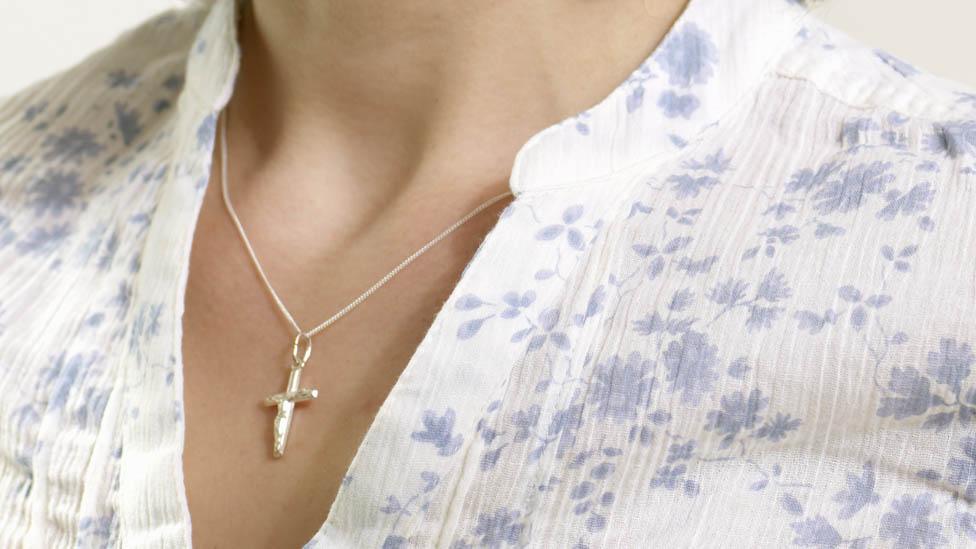Can an employer demand that you go to work naked?
- Published

"I want everyone working in this bank to come to work on Monday naked," ordered the bank manager. Hmm, would it really be acceptable for an employer to demand this? And if not, what makes a dress code reasonable or unreasonable? David Edmonds dons his thinking cap.
Question: What do tattoos, crucifixes, headscarves, beards and high-heeled shoes have in common?
Answer: they've all been the subject of sackings and disputes between employers and employees.
There was the London receptionist given the boot for not wearing high-heels, the Belgian receptionist told to hang up her hat for wearing a headscarf, the woman sacked for wearing a crucifix, the employees branded intolerant for objecting to tattoos and the firm in the cross hairs for banning facial fuzz, external.
All these stories raise the question of what an employer can require that their employees wear. Can they legitimately impose on their staff any dress code they wish?
Clare Chambers and BBC Global Philosophy Club members have their say
How then, should we think about the issue? What dress codes are reasonable?
Well, the easiest cases are those in which clothing is directly linked to the job. If you work in Disneyland, you may be expected to wear a Mickey Mouse outfit. If you work as a doctor you will have to put on medical scrubs. These rules seem unobjectionable. It's essential to the job of an actor that he or she is prepared to wear a costume. It's essential that construction workers wear hard hats.
The Cambridge philosopher Clare Chambers says a basic uniform is often uncontroversial, too.
"An employer may want employees identified in a shop or hotel. Police and lifeguards surely need to be identified."

Find out more
Would you turn up naked to work? Join the BBC Radio 4's Global Philosophy Club debate here, external

But, she says, rules become more contentious when they refer to "professional dress", and especially if they become specific. There are some items of clothing or modes of appearance that employers might want to rule out ("no shorts", "no pony-tails") and others they insist on ruling in ("you must wear a jacket"). Chambers proposes judging these codes on a two-fold test. First, is the dress code particularly harmful or uncomfortable? Second, is it discriminatory or oppressive?
On these criteria, she says, it is less objectionable to demand that men wear a tie than that women wear high heels.
"Requiring men to wear a tie is a sexist requirement, but it's not oppressive because wearing a tie is associated with being powerful and professional. It doesn't demean the man wearing a tie, and although it might be a bit uncomfortable it's not seriously damaging to the body."

The demand that women wear high heels, on the other hand, "is a requirement which is physically harmful and uncomfortable to the body," she says.
"It can cause foot and back problems. And it also connects to sexist and oppressive norms - because women wearing high heels emphasises their sexual attractiveness and their objectification, rather than their professional capacities."
Of course, there are other considerations. One is whether the company in question is a public or private institution. Clare Chambers believes that public employers have additional obligations "to ensure that the dress code does not exclude specific groups and that all citizens have an equal opportunity to be employed". So dress codes that disproportionately impact a minority and underprivileged racial group would be worse if imposed by an institution run by the state.
Another factor is how widespread enforcement of the dress code is across society. If one company in one sector of the economy banned unnatural hair dyes that would be less critical for a person with purple hair than if all companies in every sector did so.
Yet another salient point might be the degree of invasiveness. Expecting men to be clean-shaven is asking for the removal of a part of the body, or an extension to the body. If women are irritated by having to wear a skirt at work, they can always change when they get home - it's not quite so easy for a man to re-grow his beard every evening. What's more, there may be religious and ethnic sensitivities - insisting that men be clean-shaven would effectively exclude Sikhs, for example, for whom growing a beard is a religious imperative.
Religious and cultural symbols are a prickly matter, because they reflect a person's fundamental beliefs and can be central to their identity. Normally some accommodation can be found. After all, a small crucifix on a necklace is hardly intrusive.

Some might argue that wearing a burka is incompatible with being an effective primary school teacher - although there are parts of the world where this is routine. But often, when it comes to the burka, one hears a different objection - that it represents a form of patriarchal oppression, and that by "choosing" to wear one the woman is not exhibiting genuine autonomy.
This is a dangerous position to maintain, says Anne Phillips a philosopher at the London School of Economics. For one thing, it's not obvious how one would draw a distinction between a burka and, say, a mini-skirt. True, both the burka and the mini-skirt might be the product of societies which advantage men, but "on what grounds can you say the person who is wearing this form of clothing has simply been brainwashed"? Ultimately, all we can do is rely on the testimony of the woman herself. "The idea that you refuse to take someone's words for doing what they're doing is problematic. You certainly can't assume that they're lacking in any kind of agency in making their choices about what to wear."
Controversies about the burka have arisen because over the last few decades most Western liberal democracies have become multicultural. What's more, the general breakdown of rigid hierarchies in the labour force, alongside a societal decline in deference, has meant workers are often less inclined to embrace directives imposed on them from above.
For these reasons, we can be confident of one thing at least - codes about how employees should dress will increasingly get people hot under the collar.
Join the conversation - find us on Facebook, external, Instagram, external, Snapchat , externaland Twitter, external.
